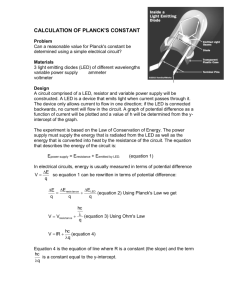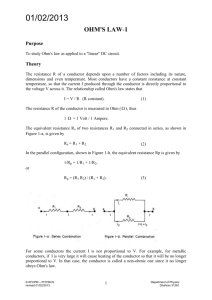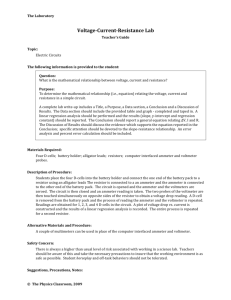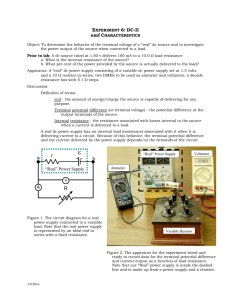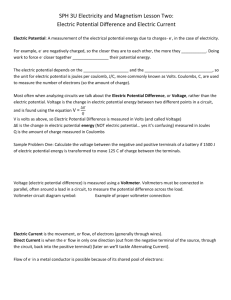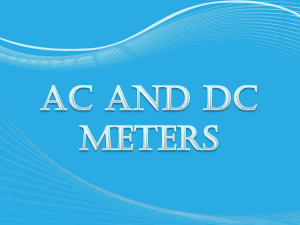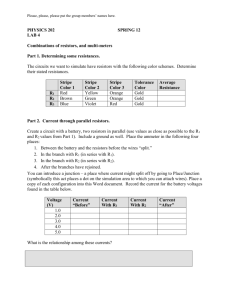Postlab
advertisement
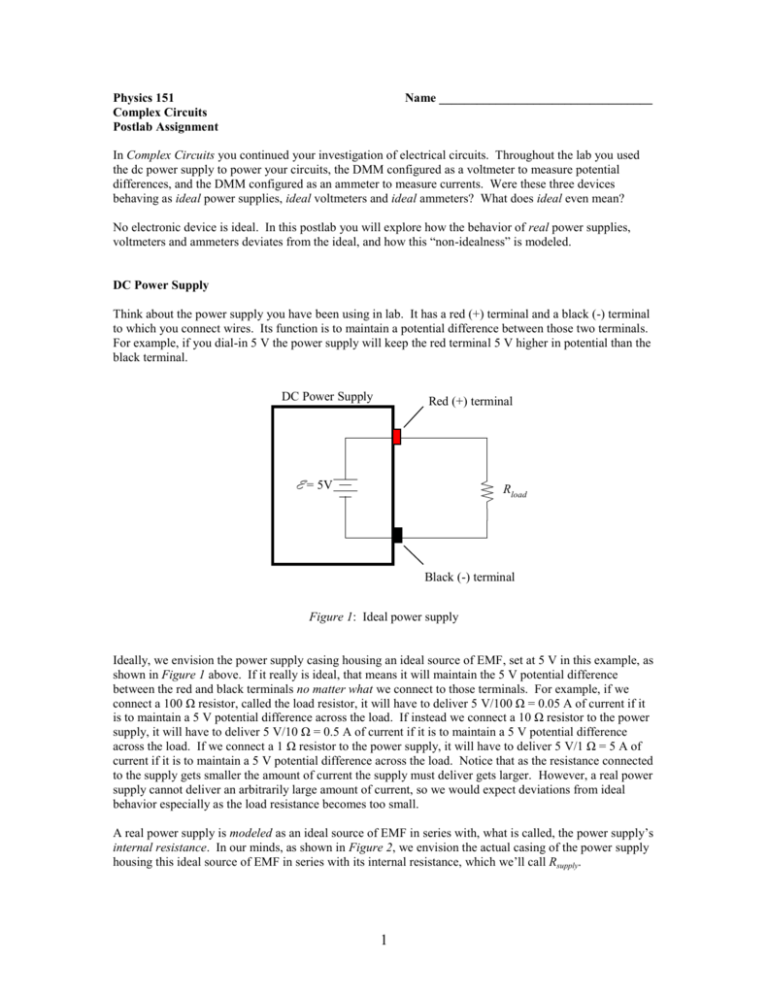
Physics 151 Complex Circuits Postlab Assignment Name __________________________________ In Complex Circuits you continued your investigation of electrical circuits. Throughout the lab you used the dc power supply to power your circuits, the DMM configured as a voltmeter to measure potential differences, and the DMM configured as an ammeter to measure currents. Were these three devices behaving as ideal power supplies, ideal voltmeters and ideal ammeters? What does ideal even mean? No electronic device is ideal. In this postlab you will explore how the behavior of real power supplies, voltmeters and ammeters deviates from the ideal, and how this “non-idealness” is modeled. DC Power Supply Think about the power supply you have been using in lab. It has a red (+) terminal and a black (-) terminal to which you connect wires. Its function is to maintain a potential difference between those two terminals. For example, if you dial-in 5 V the power supply will keep the red terminal 5 V higher in potential than the black terminal. DC Power Supply Red (+) terminal E = 5V Rload Black (-) terminal Figure 1: Ideal power supply Ideally, we envision the power supply casing housing an ideal source of EMF, set at 5 V in this example, as shown in Figure 1 above. If it really is ideal, that means it will maintain the 5 V potential difference between the red and black terminals no matter what we connect to those terminals. For example, if we connect a 100 Ω resistor, called the load resistor, it will have to deliver 5 V/100 Ω = 0.05 A of current if it is to maintain a 5 V potential difference across the load. If instead we connect a 10 Ω resistor to the power supply, it will have to deliver 5 V/10 Ω = 0.5 A of current if it is to maintain a 5 V potential difference across the load. If we connect a 1 Ω resistor to the power supply, it will have to deliver 5 V/1 Ω = 5 A of current if it is to maintain a 5 V potential difference across the load. Notice that as the resistance connected to the supply gets smaller the amount of current the supply must deliver gets larger. However, a real power supply cannot deliver an arbitrarily large amount of current, so we would expect deviations from ideal behavior especially as the load resistance becomes too small. A real power supply is modeled as an ideal source of EMF in series with, what is called, the power supply’s internal resistance. In our minds, as shown in Figure 2, we envision the actual casing of the power supply housing this ideal source of EMF in series with its internal resistance, which we’ll call Rsupply. 1 DC Power Supply Red (+) terminal Rsupply Rload E = 5V Black (-) terminal Figure 2: Model of a real power supply How does the internal resistance alter the behavior of an ideal source of EMF? To investigate, let’s continue with the example of setting the power supply to provide a 5 V potential difference across a load. With your knowledge of series circuits you can see that not all of the 5 V will appear across the load. Some fraction of it will appear across the internal resistance of the supply. Furthermore, if a very low resistance is connected to the supply, the current cannot rise arbitrarily high, the current is limited by the internal resistance of the supply. In fact, with this model, for the limiting case of zero load resistance (shortcircuiting the supply), the current can be no higher than the ideal EMF divided by Rsupply. Investigate on your own the behavior of a real supply by filling in the table below. The power supply is set for 5 V and has an internal resistance of 1Ω. Different load resistances are presented and you must calculate the current in the load and the potential difference that actually appears across the load. (Carry out your calculations to four significant figures in amps and volts.) Actual Current Ideal Terminal (Load) Voltage EMF Rsupply Rload Ideal Current 5.000 V 1.000 Ω ∞ (no load) 0.0000 A 5.000V 5.000 V 1.000 Ω 100.0 Ω 0.0500A 5.000V 5.000 V 1.000 Ω 10.00 Ω 0.5000A 5.000V 5.000 V 1.000 Ω 1.000 Ω 5.000A 5.000V 5.000 V 1.000 Ω 0.000 Ω (short) ∞ 5.000V Actual Terminal (Load) Voltage Remember, in all these cases, the supply has been set to maintain 5 V across the load. In other words, before you connect the load, you turn the knob until the meter on the front face of the supply says 5 V, fully expecting 5 V to appear across the load. But just because you dial-in 5 V doesn’t mean you will get 5 V when the load is connected. Right? (Rhetorical.) 1. Based on your calculations should you worry about this non-ideal behavior when the load resistance is large compared to the supply’s internal resistance or when the load resistance is comparable to the supply’s internal resistance? (Note: This is not a yes or no question.) 2. In this respect is a power supply better if it has a large internal resistance or a small internal resistance? 2 Ammeter Consider the circuit shown in Figure 3(a). Assuming the power supply to be an ideal source of EMF there is 0.5 A of current in the circuit. Ammeter R ammeter E = 5V Rload 10Ω Rload E = 5V (a) 10Ω (b) Figure 3 Let’s say you want to measure the current with an ammeter. You would expect a good ammeter to measure 0.5 A. However, very few measurements, if any, are completely unobtrusive. In other words, every time you use an instrument to measure something you can expect the instrument to somehow alter the value of the quantity you are measuring. It is part of your job as a scientist or engineer to be aware of your instrument’s influence on the system you are investigating, and in many cases, to design your test or experiment so that this influence is accounted for or made insignificant. Ammeter’s certainly behave in this less-than-ideal fashion. The very act of placing an ammeter in a circuit, to measure the current in the circuit, reduces the amount of current in the circuit. This non-ideal behavior can be modeled by assigning the ammeter an internal resistance of its own that will be called Rammeter. 3. The actual circuit is shown in Figure 3(a). We fully expect 0.5 A of current in this circuit. The test circuit is shown in Figure 3(b). The rectangle represents the physical casing of the ammeter. Note that it has two probes connecting it inline with the loop of the circuit in order to measure the current in the circuit. The ammeter’s internal resistance is represented by a resistor symbol placed inside of the ammeter. If the ammeter’s internal resistance is 1 Ω what will the ammeter actually measure? Show your work. 4. Based on this calculation is an ammeter better if it has a large internal resistance or a small internal resistance? Explain. 3 Voltmeter Consider the circuit shown in Figure 4(a). Assuming the power supply to be an ideal source of EMF there is 5 V dropped across each of the two identical 800 kΩ resistors. R1 R1 E 10V 800kΩ R2 800kΩ E 10V Voltmeter 800kΩ R2 800kΩ Rvoltmeter (a) (b) Figure 4 Let’s say you want to measure the potential drop across R2 with a voltmeter. You would expect a good voltmeter to measure 5 V. But just like the ammeter, a real voltmeter will alter the very quantity it is trying to measure. This non-ideal behavior of the voltmeter can be modeled by assigning the voltmeter its own internal resistance that will be called Rvoltmeter. 5. The actual circuit is shown in Figure 4(a). We fully expect 5 V to be dropped across R2. The test circuit is shown in Figure 4(b). The rectangle represents the physical casing of the voltmeter. Note that it has two probes connected across R2 in order to measure the potential difference. The voltmeter’s internal resistance is represented by a resistor symbol placed inside of the voltmeter. If the voltmeter’s internal resistance is 2 MΩ what will the voltmeter actually measure? Show your work. 6. Based on this calculation is a voltmeter better if it has a large internal resistance or a small internal resistance? Explain. 4

